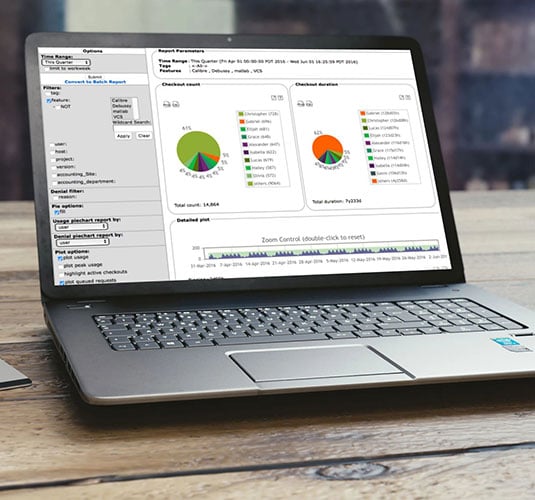
Exascale
Exascale means massive computational power; think of a system capable of a quintillion calculations per second – that’s the power of exascale. Altair is at the forefront of the exascale transformation, exploring the next level of high-performance computing (HPC). In this new exascale era, we’re pioneering tools that scale, running on next-generation systems and supporting increasingly complex HPC requirements in areas like machine learning, deep learning, and multiphysics.
HPC - Only as Powerful as the Software That Runs It
Powerful computing hardware requires powerful software tools, and with exascale it’s more critical than ever to manage workloads efficiently. Altair® PBS Professional® orchestrates it all with automated job scheduling, management, monitoring, and reporting.
Making History with Argonne’s Aurora Supercomputer
The "Aurora" exascale computer at Argonne National Laboratory’s Argonne Leadership Computing Facility (ALCF), with workload management by PBS Professional, was completed in 2023 and enables transformative science on an unparalleled scale. Aurora is capable of performing two quintillion — a billion billion, visualized as 1,000,000,000,000,000,000 — calculations per second.
Learn more about Altair PBS Professional
Learn More
Exploring Exascale
We’ve partnered with Argonne National Laboratory in support of exploring exascale with the HPE-designed Aurora system. And that’s just the start. With the advent of the exascale era, we’re pioneering tools that scale, getting them ready to run on next-generation systems and support increasingly complex HPC requirements in areas like artificial intelligence (AI), machine learning, deep learning, and multiphysics. Supercomputers are critical to the future and we’re helping shape the U.S. exascale ecosystem as a member of the Department of Energy’s Exascale Computing Project (ECP) Industry Council. We’re honored to collaborate and help better simulate the processes behind precision medicine, additive manufacturing, biofuels, and much more.

Optimizing Exascale Computing
Exascale demands speed and scale to handle billions of operations. It requires extreme resilience and continuous fault recovery. Running an exascale-class system takes significant power, so power management – and a good user experience – is paramount. We’ve considered all this and more for exascale and beyond, including:
- Altair® Accelerator™ Plus for 6-10x greater throughput
- PMIx for fast launch of huge MPI jobs
- Active-active PBS Professional server
- Green Provisioning™
- Hybrid cloud capabilities, ARM64, GPUs, and SSDs
- Dual-licensed PBS Professional with extensive plugin framework
- Altair® Control™ for monitoring, analytics, and simulation
- Security focus

Going Big
Altair® PBS Professional® runs big — 50,000 nodes in one cluster, 10,000,000 jobs in a queue, and 1,000 concurrent active users. It also runs fast — 10,000,000 jobs per hour end-to-end throughput and 10-second end-to-end run for a single 4,000+ node job. Many of the world’s biggest computing systems use PBS Professional to power efficient workload management, and today’s exascale systems will have widespread implications for the future in industries from manufacturing to personalized medicine, enabling users to stay at the forefront of innovation. Join us on the cutting edge of HPC.
Featured Resources

Tracking Virus Variants with AI – Argonne National Laboratory Researchers Win Gordon Bell Special Prize
The COVID-19 pandemic has impacted the entire planet, and researchers continue to investigate its catalyst: the SARS-CoV-2 virus and its variants. Discovering variants of concern (VOCs) quickly can save lives by giving scientists time to develop effective vaccines and treatments — but existing variant-tracking methods can be slow. A team of researchers at Argonne National Laboratory, along with university and industry collaborators, tackled the problem of tracking virus variants by using artificial intelligence (AI). The powerful Polaris supercomputer at the Argonne Leadership Computing Facility (ALCF), which is enabling science in the runup to the Aurora exascale system, enabled the research with help from Cerebras' AI-hardware accelerator and NVIDIA's GPU-accelerated Selene system. Polaris is equipped with GPUs and with workload orchestration by Altair® PBS Professional®. The project team won the ACM's prestigious 2022 Gordon Bell Special Prize for High Performance Computing-Based COVID-19 Research. The results the Argonne researchers and their collaborators have achieved paves the way for faster, more detailed insight into the virus mutation process, enabling scientists to act on emergent variants and develop ammunition to reduce severity and slow the spread, ultimately saving lives.

Simulating Supernovas in 3D - University Researchers Advance Space Science with Argonne HPC Resources
Everything in our world and beyond is made from a common set of materials — elements — that combine to become the diverse collection of matter all around us. When a star dies, going supernova in a spectacular explosion, it releases massive quantities of these elements. But how and why stars go supernova remains a mystery, and researchers from Princeton University and the University of California, Berkeley are using supercomputers at the Argonne Leadership Computing Facility (ALCF), including the powerful Polaris supercomputer, to enable 3D supernova simulation. Polaris is boosted by GPUs and equipped with workload orchestration by Altair® PBS Professional®, which automates job scheduling, management, monitoring, and reporting. Efficient workload management is critical for large, complex workloads like these. Enabled by powerful HPC, the researchers have created "the largest collection of sophisticated 3D supernova simulations ever performed."

Outstanding Scalability at NIAR - Advanced crash analysis solution proves twice as fast as leading competitor
To support its goal of accelerating the development cycle, early in 2020 NIAR commissioned a study to assess the scalability of Altair Radioss™, Altair’s structural analysis solver for highly non-linear problems under dynamic loadings. Regular support from an Altair engineer ensured swift familiarization with Radioss. The study was performed on Oracle Cloud Infrastructure (OCI). OCI with its bare metal HPC shapes that use low latency RDMA interconnect provided highly scalable infrastructure-as-a-service (IAAS) for Radioss.





